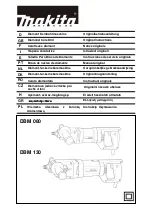
3
The spindle on right angle positive feed drills retracts at a much
faster rate than it feeds. Care should be taken to avoid entrapment.
Nose pieces usually used with these drills are generally slotted for
visibility and access to chuck, cutter, and retract stop adjustments.
A spindle guard should be used when operating tool. Spindle
guards in one inch increments are available to accommodate any
length spindle. Slotted spindle guards are available for tools with
fluid swivels.
Drilling or other use of this tool may produce hazardous fumes and/
or dust. To avoid adverse health effects utilize adequate ventilation
and/or a respirator. Read the material safety data sheet for any
cutting fluids or materials involved in the drilling process.
• Most dusts are combustible. See material safety data sheets for
combustibility of a specific dust.
• Non ferrous metal dusts are particularly haxardous.
Examples: Aluminum, Magnesium, Titanium, Zirconium
(Never collect Magnesium in a dry dust collector)
• Never collect spark generating material in the same dust collector
with combustible material.
Examples: Collecting both Steel and Aluminum dust or Steel and
Titanium dust.
• Never use flamable finishing lubricants.
Safety Recommendations
Some individuals are susceptible to disorders of the hands and arms
when exposed to tasks which involve repetitive work motions. Those
individuals predisposed to vasculatory or circulatory problems may
be particularly susceptible. Cumulative trauma disorders such as
carpal tunnel syndrome and tendinitis may be caused or aggravated
by repetitious, forceful exertions of the hands and arms. These
disorders develop gradually over periods of weeks, months, and
years.
• Tasks should be performed in such a manner that the wrists
are maintained in a neutral position, which is not flexed,
hyperextended, or turned side to side.
• Stressful postures should be avoided and can be controlled
through tool selection and work location.
Any tool operator should be aware of the following warning signs and
symptoms so that a problem can be addressed before it becomes a
debilitating injury. Any user suffering prolonged symptoms of tin-
gling, numbness, blanching of fingers, clumsiness or weakened
grip, nocturnal pain in the hand, or any other disorder of the
shoulders, arms, wrists, or fingers is advised to consult a physician.
If it is determined that the symptoms are job related or aggravated
by movements and postures dictated by the job design, it may be
necessary for the employer to take steps to prevent further occur-
rences. These steps might include, but are not limited to, reposition-
ing the workpiece or redesigning the workstation, reassigning work-
ers to other jobs, rotating jobs, changing work pace, and/or changing
the type of tool used to minimize stress on the operator. Some tasks
may require more than one type of tool to obtain the optimum
operator/tool/task relationship.
The following recommendations will help reduce or moderate the
effects of repetitive work motions. The operator of any drill should:
• Use a minimum hand grip force consistent with proper control and
safe operation
• Keep body and hands warm and dry
• Avoid anything that inhibits blood circulation
— Smoking Tobacco
— Cold Temperatures
— Certain Drugs
• Avoid awkward postures
• Keep wrists as straight as possible
• Interrupt work activities, or rotate jobs to provide periods free from
repetitive work motions.
CAUTION
!
WARNING
!
Extension
Neutral
Flexion
Radial Deviation
Neutral
Ulnar Deviation
Avoid
Avoid
Avoid
OK
Avoid
OK
WARNING
!
Wear respirator where
necessary.
Keep hands and fingers away from
slot in spindle guard and nose piece
when handling or operating tool.
WARNING
!




































